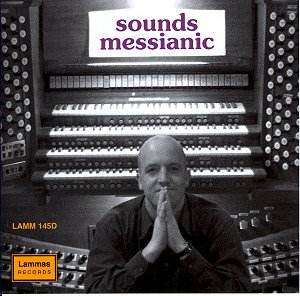An intriguing disc.
The coupling of Messiaen and the Belgian
composer César Franck is an inspired
one. Messiaen’s Les Corps Glorieux
(‘The Glorified Bodies’) is a heady,
almost intoxicating statement of Roman
Catholic mysticism. Written when the
composer was in his twenties, the piece
is subtitled, ‘Seven Brief Visions of
the Life of the Resurrected’. Jamie
Hitel, in the Messiaen at least, is
fully committed and inside the musical
sound-world. Musically, the Franck complements
it beautifully.
The first three movements
centre around spiritual peace. The first
movement, ‘Subtilité des Corps
Glorieux’ (‘The Subtleness of the Glorified
Bodies’, as translated in the booklet)
is pure monody. Freed from earthly concerns,
the liberated bodies can float freely,
as indeed the melody twists and turns.
Immediately identifiable as Messiaen,
the music’s own hypnotic journey gives
out the musical language horizontally:
the ear is therefore fully attuned for
the vertical sonorities of ‘Les Eaux
de la Grâce’ (‘The Waters of Grace’).
This refers to the river of grace running
through the Heavenly City, and this
gentle polymodal vision is held at a
restrained dynamic level, at once reverential
yet holding within it the capacity to
unleash spiritual ecstasy.
The same shadowy aura
shines around ‘L’Ange aux Parfums’ (‘The
Angel of the Incense’). This is music
replete with half-voices, silvery and
other-worldly. The first three movements
act in contrast to the ‘Combat de la
Mort et de la Vie’ (‘The Struggle between
Death and Life’), the longest section
of Corps Glorieux. The writing
is intensely pictorial in the first
part of this movement, a Messiaen battle
scene, a struggle against the inevitability
of Death. Hitel delivers the fast-moving
chords with consummate virtuosity. Visceral
and physically involving (it is like
being pummelled for four minutes by
blocks of sound), the contrasting and
longer section radiates serenity. This
is extended peace, the harmonies almost
unbearably tender.
The next two movements
concentrate on various attributes of
the glorified bodies. ‘Force et Agilité
des Corps Glorieux’ (‘The Power and
Agility of the Glorified Bodies’) begins
like a call-to-arms. These beautiful
angels are possessed of a strong backbone
of grace. Again monody is used, here
with a supple rhythm that conveys the
joy of movement. The power of Messiaen’s
sensitivity to intervallic colour is
shown at its best in the sixth movement,
‘Joie et Clarté des Corps Glorieux’
(The Joy and Radiance of the Glorified
Bodies’). There is a definable contained
ecstasy in the harmonies which makes
this compelling.
The Mystery of the
Holy Trinity (‘Le Mystère de
la Sainte Trinité’) is a concept
that was close to the composer’s heart.
Number symbolism (three, of course)
is paramount here in this final section.
The music itself is delicate, almost
preternaturally fragile (as the booklet
notes say, ‘It seems to call us from
beyond’). The meditational aspect of
this movement almost seems to take the
experience to a different plane. Hitel’s
focused concentration is all one could
ask for.
The coupling of Franck’s
Choral No. 1 in E works very well musically,
although there is too little gap between
the two pieces on this disc. One of
Franck’s last statements, the trithematic
Choral (initially dedicated to Alexandre
Guilmant, then in the final printed
score to Eugène Gigout) is difficult
to bring off. It can so easily sound
diffuse, as indeed alas it does here.
The most successful part is towards
the end, a majestic chorale (around
11’25) and a jubilant close, but the
end impression is that Hitel does not
quite understand this elusive piece.
André Isoir’s 1975 recording
on Calliope (CAL9920/1, available via
LudwigvanWeb) is far superior.
Isoir is more flowing, with a more identifiable
sense of direction and a clearer idea
of form. Under his fingers, the close
is truly resplendent and climactic.
The recording on the
new Lammas disc is fine and clear and
the organ is obviously an instrument
of some majesty. I was not aware Akron,
Ohio, was famous for anything other
than founding Alcoholics Anonymous.
They obviously own a fine piece of organery,
too.
Colin Clarke
